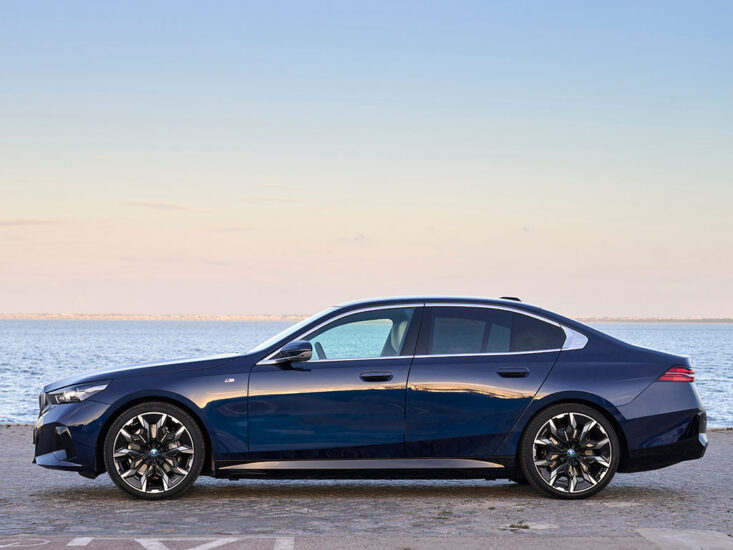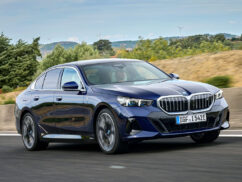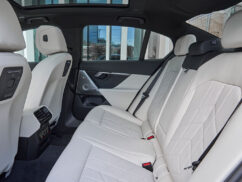First drive: 2024 BMW i5 in Portugal
BMW is going electric. Well, it hasn’t ditched combustion power just yet – and may not do so for at least the foreseeable future – but the Bavarian marque’s agenda is to electrify a substantial chunk of its lineup by the end of the decade. In a telling sign of what’s to come, the all-new G60 5 Series (due on sale locally by the end of the year) has been split into two distinct offerings. As before, there will be the petrol-powered 520i, 530i, 540i and (eventually) M5, but, for the first time, there are also battery-powered BMW i5 models.
The i5 sedans are likely to account for a significant slice of 5 Series sales in Europe, while growing acceptance of BEVs in our region should ensure they fare reasonably well in the UAE market, too.
Exterior design
Unlike arch-rival Mercedes-Benz, which clearly differentiates combustion models such as the E-Class and S-Class from the electrified EQE and EQS (which sit on entirely different platforms), BMW has opted for a more homogenous approach, with only minor external details distinguishing i5 models from their petrol-powered counterparts.

The i5 is certainly less polarising visually than the huge-grilled i7/7Series, and it’s unlikely to alienate any potential buyers via its aesthetics. BMW quotes a drag coefficient of 0.23 for the i5, which makes it one of the slipperiest production cars through the air.
Two i5 variants will be on sale initially – the entry-level i5 eDrive40 and the sporty dual-motor i5 M60 xDrive. We drove both at the international launch and found them to be engaging driver’s cars that are also big on practicality.
BMW’s latest-gen mid-sizer has grown substantially – it measures 5,060mm long, 1,900mm wide and has a wheelbase of 2,995mm – which means it’s larger than even a 1980s long-wheelbase 7 Series. The dimensional increase means there’s generous leg- and headroom in both front and rear compartments, while boot capacity is a respectable 490 litres.

BMW i5 Performance
Housed under the passenger compartment is an 81.2kWh battery pack, and, in the base-model i5 eDrive40, a single electric motor powers the rear axle. Outputs of 340hp and 430Nm (in My Mode Sport) yield a 0-100kph split of 6.0sec and an electronically governed top speed of 193kph, even though the vehicle weighs a hefty 2,130kg.
The i5 M60 xDrive ups the ante substantially as dual electric motors (one each for front and rear axles) thrash out combined outputs of 601hp and 820Nm. For some buyers, the M60 might make the upcoming M5 redundant as it scorches from 0-100kph in just 3.8sec and is electronically limited to 230kph (more than adequate for public roads).
BMW quotes a touring range of between 497km and 582km for the eDrive40 on a full charge, while the i5 M60 xDrive can cover between 455km and 516km, according to the WLTP cycle. According to BMW, access to a fast-charging station will enable you to top up from 10 percent to 80 percent charge in 30 minutes.

Ride and comfort
The i5 eDrive40 was the first car we sampled at the launch, and first impressions were dominated by the EV’s ultra-silent cruising capability and supple ride. In terms of refinement, the i5 is up there with most contemporary luxury limos.
The healthy quota of instant torque on tap means the eDrive40 feels punchier than expected around town and even on open country roads. There’s enough urge in reserve to enable safe and easy overtaking on the highway. At the same time, accurate (if not particularly communicative) steering and an agile chassis add to the feel-good factor behind the wheel.
All 5 Series/i5 are underpinned by BMW’s CLAR ‘Cluster Architecture’, with double-wishbone coil-sprung front suspension and a five-link rear. The electrified (and therefore heavy) i5 is equipped with air suspension at the rear, contributing to the car’s compliant ride characteristics.

Exact GCC spec levels are yet to be announced, but M suspension with fixed dampers is the entry-level setup in Euro-spec cars. In contrast, Adaptive Professional suspension is the mid-spec option and can be combined with optional rear-wheel steering (Integral Active Steering, in BMW-speak).
The latter steers the rear wheels up to 2.5 degrees, leaving decent room for luggage space and a 285-section tyre on 21-inch alloys (18s, 19s, and 20s are also available).
BMW i5 M60 xDrive
We sampled the muscle-bound i5 M60 xDrive on the second day of the drive event in Portugal, and the range-topper’s added clout becomes evident once the road opens up and there’s sufficient space to stretch its legs.

As reflected by its 601hp/820Nm, the M60 packs a hefty wallop, and occupants will feel their spines being compressed into the seatback anytime the driver flattens the throttle. You can add to the sense of drama by activating a synthesised soundtrack. This futuristic spaceship-esque sound rises in volume and intensity as you increase the pressure on the throttle pedal.
The M60 comes standard with Adaptive M Professional, which combines rear-wheel-steer with active roll stabilisation (active anti-roll bars with 48-volt electric motors), enhancing its sense of dynamism across sinuous roads.
Undoubtedly, the i5 M60 feels discernibly faster than the entry-level eDrive40, but I’m not convinced it’s worth the extra spend as the base model is rapid enough to satisfy most tastes. In addition, the eDrive40’s sprightlier girth (it weighs 175kg less than the M60) and rear-drive (as opposed to AWD) format make it feel nimbler and more enjoyable to punt across winding roads.

Interior design
As with all new-gen BMWs, the interior designers have done away with most physical buttons. BMW’s Curved Display features the familiar 12.3-inch and 14.9-inch screens nestled next to each other behind a common glass surface. Live Cockpit Plus with cloud-based navigation is standard. Live Cockpit Professional adds a head-up display and Augmented View, which displays graphic turn arrows on a camera image of the road ahead.
The i5’s surprise-and-delight elements include an ‘Interaction Bar’, a glass-look light and a function bar integrated into the instrument panel. By swiping or tapping the integrated control buttons, you can regulate the amount of air for the integrated air vents, operate the exterior lighting as well and activate or deactivate the defrost function for the windscreen, the rear window heating and the hazard warning lights.
The i5 also scores the latest-generation BMW OS infotainment system carried across from the i7 and 7-series. In addition, BMW has partnered up with AirConsole to provide the driver and passengers with the opportunity to play games when the car is stationary.
As for driver and infotainment tech, Automated Lane Change with eye activation is a world-first, and there’s also familiar tech such as hands-off driving, active cruise with traffic-light recognition and remote-control parking among 40-plus systems from the 7 Series. However, we’ve yet to find out whether these features will be available in GCC-spec cars.

Verdict
Overall, the state-of-the-art i5 is a deeply impressive vehicle that seems almost certain to broaden the reach of the 5 Series sedan in Europe and markets such as the UAE. With 620 charging stations in Dubai alone by the end of last year, EV ownership is becoming more feasible, even for buyers who don’t live in a villa and therefore can’t have their own wall box.
Most importantly, the i5 retains the fun-to-drive characteristics that have been an inherent trait of the 5 Series ever since the first-gen model debuted in 1972. We’re prepared to give it a provisional thumbs-up, which we’ll confirm once we’ve driven it on home soil.
















There are no comments. Be the first!